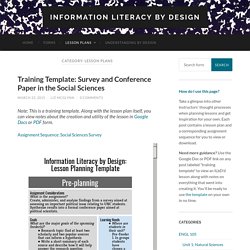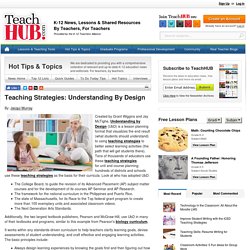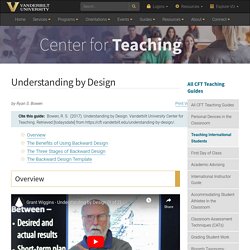

Information Literacy by Design Creating a Teaching & Training Template for Developing Library Instructors. Lesson Plans – Information Literacy by Design. Note: This is a training template.

Along with the lesson plan itself, you can view notes about the creation and utility of the lesson in Google Docs or PDF form. Assignment Sequence: Social Sciences Survey. Information Literacy by Design. Backward Design. Backward Design The first time I heard about backward design was back in 2008 when I attended the ACRL Information Literacy Immersion Institute.

Debra Gilchrist, Vice President for Learning and Student Success at Pierce College and an expert in assessment, gave an excellent workshop about incorporating different assessment techniques into lesson plans. Although she didn’t use the term, her approach was very similar to what I would later know as backward design. Understanding by Design Framework by on Prezi. Teaching Strategies: Understanding By Design. Created by Grant Wiggins and Jay McTighe, Understanding by Design (UbD) is a lesson planning format that visualizes the end result (what students should understand) to using teaching strategies to better select learning activities (the path that will get students there).

Tens of thousands of educators use these teaching strategies for unit and course planning; hundreds of districts and schools use these teaching strategies as the basis for their curricula. Look at who has adopted UbD: The College Board, to guide the revision of its Advanced Placement (AP) subject matter courses and for the development of its courses AP Seminar and AP Research. The framework for the national curriculum in the Philippines and Puerto Rico. The state of Massachusetts, for its Race to the Top federal grant program to create more than 100 exemplary units and associated classroom videos. Defined STEM Understanding by Design (UbD) (A) Use of the Website (a) The website (hereinafter "Website") is owned and operated by Defined Learning,.

Unless otherwise indicated, the content, format and imagery of the Website are copyrighted under the laws of the United States by Defined Learning, and are protected by worldwide copyright laws and treaty provisions. Unauthorized duplication is a violation of law. The content, format and imagery of the Website may not be copied, published, broadcast, distributed, reproduced or transmitted in any way. You may not use the Website or any materials on the Website in any commercial or for-profit manner. Understanding by Design - Eduplanet21. Understanding by Design. Overview Understanding by Design is a book written by Grant Wiggins and Jay McTighe that offers a framework for designing courses and content units called “Backward Design.”

Instructors typically approach course design in a “forward design” manner, meaning they consider the learning activities (how to teach the content), develop assessments around their learning activities, then attempt to draw connections to the learning goals of the course. In contrast, the backward design approach has instructors consider the learning goals of the course first. What is Understanding by Design? Author Jay McTighe explains. Grant Wiggins - Understanding by Design (1 of 2) Authentic Education - What is UbD™? Understanding by Design® (UbD™) is a framework for improving student achievement.

Emphasizing the teacher's critical role as a designer of student learning, UbD™ works within the standards-driven curriculum to help teachers clarify learning goals, devise revealing assessments of student understanding, and craft effective and engaging learning activities. Developed by nationally recognized educators Grant Wiggins and Jay McTighe, and published by the Association for Supervision and Curriculum Development (ASCD), Understanding by Design® is based on the following key ideas: A primary goal of education should be the development and deepening of student understanding.
Students reveal their understanding most effectively when they are provided with complex, authentic opportunities to explain, interpret, apply, shift perspective, empathize, and self-assess. Educational Leadership:Using Data to Improve Student Achievement:Backward Design for Forward Action. Educational Leadership:Reshaping High Schools:Put Understanding First. Understanding by Design® framework - Videos, Articles, Resources, Experts. Why Instructional Design Must Focus on Learning Outcomes, Not Learning Activities.
It’s no secret that kids learn better when teachers provide learning activities that keep them engaged. Teachers work tirelessly to plan engaging lessons that capture and keep the interests of their students, thereby making content more accessible. However, teachers continue to feel the daunting pressure to compete for their students’ attention amidst the ever-evolving and rapidly-hanging mass media, social media, and entertainment industry, as these elements do a stellar job of keeping students highly engaged outside of the classroom.
Although it is vitally important for us to know and understand our students' interests and the best conditions under which they learn, there is good news: It’s not necessary that we focus our efforts on competing with the devices and activities our students engage in during their downtime outside of the classroom! Recreation, entertainment, and downtime for students outside of the classroom are just that: recreation, entertainment, and downtime. Educational Leadership:Teaching for Meaning:You Can Teach for Meaning. Educational Leadership:Feedback for Learning:Seven Keys to Effective Feedback. Educational Leadership:Teaching for Authentic Student Performance:Practicing What We Preach in Designing Authentic Assessments.
Educational Leadership:Getting Students to Mastery:How Good Is Good Enough? Introduction: What is UbD FRAMEWORK? VoiceThread: UbD at New Heights Academy. A Summary of Underlying Theory and Research2. Overview of UbD & The Design Template.